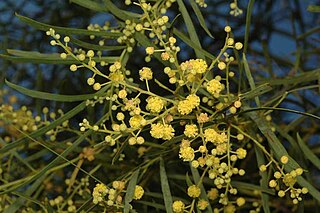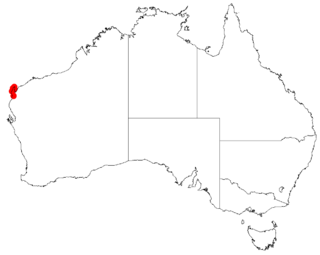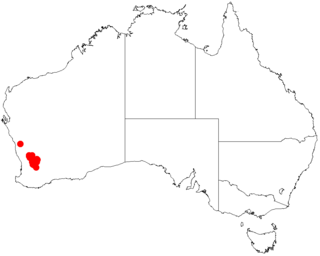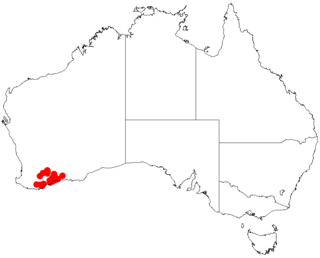
Acacia acanthoclada, commonly known as harrow wattle, is a species of flowering plant in the family Fabaceae and is endemic to southern continental Australia. It is a low, highly branched, spreading and spiny shrub with wedge-shaped to triangular or egg-shaped phyllodes with the narrower end towards the base, and spherical heads of up to 30 flowers, and linear, spirally-coiled pods.

Acacia arcuatilis is a shrub belonging to the genus Acacia and the subgenus Juliflorae that is endemic to south western parts of Australia.

Acacia acuaria is a species of flowering plant in the family Fabaceae and is endemic to the south-western of Western Australia. It is a rounded or diffuse to spreading, prickly shrub with sharply pointed, rigid, needle-shaped phyllodes, flowers arranged in more or less spherical heads of 14 to 23 flowers, and strongly curved or openly coiled pods up to 50 mm (2.0 in) long.

Acacia adinophylla is a species of flowering plant in the family Fabaceae and is endemic to a small area in the south-west of Western Australia. It is a prostrate to erect, scrambling shrub with cylindrical branchlets, narrowly wedge-shaped to lance-shaped phyllodes, flowers arranged in up to 4 spherical heads of dull golden yellow flowers, and paper-like pods.

Acacia aestivalis is a species of flowering plant in the family Fabaceae and is endemic to the south-west of Western Australia. It is a bushy shrub or tree with linear to narrowly lance-shaped phyllodes, the narrower end towards the base, racemes of 5 to 11 spherical heads of golden-yellow flowers, and glabrous, papery to thinly leathery pods.

Acacia alexandri is a species of flowering plant in the family Fabaceae and is endemic to the Cape Range in the north-west of Western Australia. It is a glabrous shrub with slender branchlets, linear phyllodes, and cream-coloured flowers arranged in 1 or 2 spherical heads in the axils of phyllodes, and narrowly oblong, papery pods up to 70 mm (2.8 in) long.

Acacia amblygona, commonly known as fan wattle or fan leaf wattle, is a species of flowering plant in the family Fabaceae and is endemic to continental Australia. It is a sprawling, sometimes prostrate shrub with sharply-pointed, lance-shaped, tapering phyllodes, golden-yellow flowers arranged in a spherical head of 10 to 18 in the axils of phyllodes, and curved, coiled or twisted pods up to 70 mm (2.8 in) long.

Acacia hastulata is a shrub belonging to the genus Acacia and the subgenus Phyllodineae that is endemic to an area in south western Australia.

Acacia phaeocalyx is a shrub belonging to the genus Acacia and the subgenus Phyllodineae that is endemic to south western Australia.

Acacia pycnocephala is a shrub of the genus Acacia and the subgenus Phyllodineae that is endemic to south western Australia.

Acacia sericocarpa is a shrub of the genus Acacia and the subgenus Phyllodineae that is endemic to south western Australia.

Acacia sphacelata is a shrub of the genus Acacia and the subgenus Phyllodineae that is endemic to south western Australia.
Acacia adnata is a species of flowering plant in the family Fabaceae and is endemic to a small area in the south-west of Western Australia. It is a shrub with sessile, oblong, sharply pointed phyllodes, and leathery, linear pods. The flowers are unknown.

Acacia brachyphylla is a shrub of the genus Acacia and the subgenus Plurinerves that is endemic to a small area in south western Australia.

Acacia densiflora is a shrub of the genus Acacia and the subgenus Plurinerves that is endemic to an area of south western Australia.

Acacia tetanophylla is a shrub of the genus Acacia and the subgenus Plurinerves that is endemic to an area of south western Australia.

Acacia undosa is a shrub of the genus Acacia and the subgenus Plurinerves that is endemic to an area of south western Australia.

Acacia trineura, known colloquially as three-nerve wattle or three nerved wattle or green wattle, is a species of Acacia native to south eastern Australia.

Acacia aculeatissima, commonly known as thin-leaf wattle or snake wattle, is a species of flowering plant in the family Fabaceae and is endemic to south-eastern continental Australia. It is usually a prostrate shrub with sharply pointed, needle-shaped phyllodes, flowers arranged in up to 3 more or less spherical heads of 15 to 25 flowers, and linear, papery pods up to 60 mm (2.4 in) long.

Acacia alleniana is a species of flowering plant in the family Fabaceae and is endemic to northern parts of Australia. It is a spindly, open shrub or tree with slender branchlets, thread-like phyllodes, and yellow flowers arranged in 2 to 6 spherical heads in the axils of phyllodes, and thinly leathery pods up to 150 mm (5.9 in) long.



















